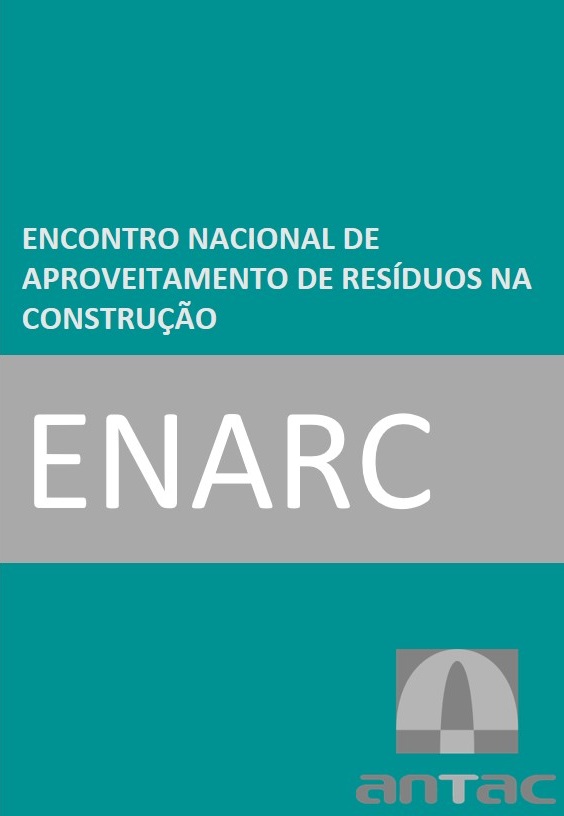A systematic bibliography review on life cycle assessment and carbon uptake in cementitious materials
DOI:
https://doi.org/10.46421/enarc.v8i00.4630Keywords:
Life cycle assessment, CO2 uptake, Cementitious materialsAbstract
Faced with already perceptible climate changes, it is increasingly necessary to adopt practices that are more aligned with the concepts of sustainable development. Life Cycle Assessment (LCA) is a method used globally to assess potential environmental impact indicators of the most diverse products and services throughout their life cycle. In civil construction, specifically, the removal of raw material, transportation, construction, use phase, demolition, recycling, reuse, etc. It is used to study the potential of new materials and construction methods, waste management and for environmental certification of buildings and products. The application of this tool enables the diagnosis of each step involved in the process to, consequently, support the decision-making of consumers, companies, and governments. In the recent years, some researchers have been using carbon capture as a method to decrease the CO2 balance for cement-based materials. This article aims to carry out a literature review about the method and its application to evaluate the benefits of carbon dioxide capture for cementitious materials. With this, it will be possible to observe gaps to be filled to improve the coverage at the national and international level. It was possible to perceive that the biggest gaps reside in the data for the inventory, the function unit applied and the lack of standards for this specific application.
References
ANDERSSON, R. et al. Carbonation as a method to improve climate performance for cement based material. Cement and Concrete Research, v. 124, 1 out. 2019.
ANDRADE, C.; SANJUÁN, M. Á. Updating carbon storage capacity of Spanish cements. Sustainability (Switzerland), v. 10, n. 12, p. 1–15, 2018.
AREHART, J. H. et al. Carbon sequestration and storage in the built environment. Sustainable Production and ConsumptionElsevier B.V., , 1 jul. 2021.
ARRIGONI, A. et al. Life cycle assessment of natural building materials: the role of carbonation, mixture components and transport in the environmental impacts of hempcrete blocks. Journal of Cleaner Production, v. 149, p. 1051–1061, 15 abr. 2017.
BATUECAS, E. et al. Recycling CO2from flue gas for CaCO3nanoparticles production as cement filler: A Life Cycle Assessment. Journal of CO2 Utilization, v. 45, 1 mar. 2021.
CALDAS, L. R. et al. Building materials in a circular economy: The case of wood waste as CO2-sink in bio concrete. Resources, Conservation and Recycling, v. 166, 1 mar. 2021.
CHICAIZA, C. et al. Carbon storage technologies applied to rethinking building construction and carbon emissions. IOP Conference Series: Earth and Environmental Science. Anais...IOP Publishing Ltd, 1 jun. 2021.
COLLINS, F. 2nd generation concrete construction: carbon footprint accounting. v. 20, n. 4, 2013.
CUNHA, I. Quantificação das emissões de CO2 na construção de unidades residenciais unifamiliares com diferentes materiais. p. 136, 2016.
DA SILVA, S. R.; DE OLIVEIRA ANDRADE, J. J. Investigation of mechanical properties and carbonation of concretes with construction and demolition waste and fly ash. Construction and Building Materials, v. 153, p. 704–715, 2017.
DACIC, A.; FENYVESI, O. LIMITATIONS OF LIFE CYCLE ASSESSMENT OF GREEN CONCRETES - A STATE-OF-THE-ART REVIEW. Acta Polytechnica CTU Proceedings. Anais...Czech Technical University in Prague, 3 mar. 2022.
DE OLIVEIRA ANDRADE, J. J. et al. Evaluation of mechanical properties and carbonation of mortars produced with construction and demolition waste. Construction and Building Materials, v. 161, p. 70–83, 2018.
ENGINEERING VILLAGE. Engineering Village. Disponível em: <https://engineeringvillage.com>. Acesso em: 30 nov. 2020.
EUROSTAT. Statistics | Eurostat. Disponível em: <https://ec.europa.eu/eurostat/databrowser/view/cei_wm040/default/table?lang=en>. Acesso em: 19 dez. 2020.
JANG, J. G. et al. Review on recent advances in CO2 utilization and sequestration technologies in cement-based materials. Construction and Building Materials, v. 127, p. 762–773, 2016.
LI, L. et al. Comparative life cycle assessment to maximize CO2 sequestration of steel slag products. Construction and Building Materials, v. 298, 6 set. 2021.
Life Cycle Assessment Handbook. [s.l: s.n.].
MÜLLER, L. J. et al. A Guideline for Life Cycle Assessment of Carbon Capture and Utilization. Frontiers in Energy Research, v. 8, 14 fev. 2020.
PARK, J.; TAE, S.; KIM, T. Life cycle CO 2 assessment of concrete by compressive strength on construction site in Korea. Renewable and Sustainable Energy Reviews, jun. 2012.
PITTAU, F. et al. Retrofit as a carbon sink: The carbon storage potentials of the EU housing stock. Journal of Cleaner Production, v. 214, p. 365–376, 20 mar. 2019.
POSSAN, E.; FELIX, E. F.; THOMAZ, W. A. CO2 uptake by carbonation of concrete during life cycle of building structures. Journal of Building Pathology and Rehabilitation, v. 1, n. 1, p. 1–9, 2016.
RIGO, E. Avaliação do potencial de captura de CO2 de concretos com resíduos de construção e demolição devido à carbonatação. Programa de pós-graduação em Engenharia Civil, v. 8, n. 5, p. 55, 2019.
SAMPAIO, M. I. C. Qualidade de artigos incluídos em revisão sistemática: Comparação entre latino-americanos e de outras regiões. 2013.
SANJUÁN, M. Á. et al. Carbon dioxide uptake by mortars and concretes made with Portuguese cements. Applied Sciences (Switzerland), v. 10, n. 2, 2020.
SANTOS, T. et al. Life cycle assessment of mortars: A review on technical potential and drawbacks. Construction and Building Materials, v. 288, p. 123069, 2021.
SCIENCE DIRECT. Science Direct. Disponível em: <https://www.elsevier.com/solutions/sciencedirect>. Acesso em: 30 nov. 2020.
SCOPUS. Scopus. Disponível em: <https://www.elsevier.com/solutions/scopus/why-choosescopus>. Acesso em: 30 nov. 2020.
SHI, J.; ZHOU, J.; ZHU, Q. Barriers of a closed-loop cartridge remanufacturing supply chain for urban waste recovery governance in China. Journal of Cleaner Production, v. 212, p. 1544–1553, 1 mar. 2019.
SINGH, A. et al. Review of Life-Cycle Assessment Applications in Building Construction. Journal of Architectural Engineering, v. 17, n. 1, p. 15–23, 2011.
TORRENTI, J. M. et al. The FastCarb project: Taking advantage of the accelerated carbonation of recycled concrete aggregates. Case Studies in Construction Materials, v. 17, 1 dez. 2022.
WBCSD - WORLD BUSINESS COUNCIL FOR SUSTAINABLE DEVELOPMENT. Roadmap Tecnológico. 2020.
ZHANG, D.; LI, V. C.; ELLIS, B. R. Optimal Pre-hydration Age for CO2 Sequestration through Portland Cement Carbonation. ACS Sustainable Chemistry and Engineering, v. 6, n. 12, p. 15976–15981, 2018.

